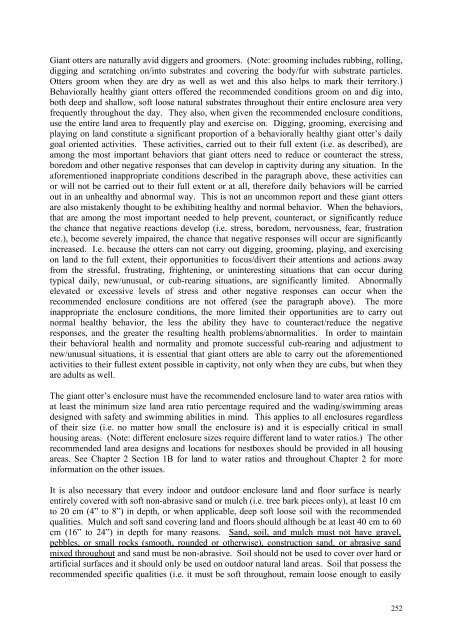International Giant Otter Studbook Husbandry and Management
International Giant Otter Studbook Husbandry and Management
International Giant Otter Studbook Husbandry and Management
Create successful ePaper yourself
Turn your PDF publications into a flip-book with our unique Google optimized e-Paper software.
<strong>Giant</strong> otters are naturally avid diggers <strong>and</strong> groomers. (Note: grooming includes rubbing, rolling,<br />
digging <strong>and</strong> scratching on/into substrates <strong>and</strong> covering the body/fur with substrate particles.<br />
<strong>Otter</strong>s groom when they are dry as well as wet <strong>and</strong> this also helps to mark their territory.)<br />
Behaviorally healthy giant otters offered the recommended conditions groom on <strong>and</strong> dig into,<br />
both deep <strong>and</strong> shallow, soft loose natural substrates throughout their entire enclosure area very<br />
frequently throughout the day. They also, when given the recommended enclosure conditions,<br />
use the entire l<strong>and</strong> area to frequently play <strong>and</strong> exercise on. Digging, grooming, exercising <strong>and</strong><br />
playing on l<strong>and</strong> constitute a significant proportion of a behaviorally healthy giant otter’s daily<br />
goal oriented activities. These activities, carried out to their full extent (i.e. as described), are<br />
among the most important behaviors that giant otters need to reduce or counteract the stress,<br />
boredom <strong>and</strong> other negative responses that can develop in captivity during any situation. In the<br />
aforementioned inappropriate conditions described in the paragraph above, these activities can<br />
or will not be carried out to their full extent or at all, therefore daily behaviors will be carried<br />
out in an unhealthy <strong>and</strong> abnormal way. This is not an uncommon report <strong>and</strong> these giant otters<br />
are also mistakenly thought to be exhibiting healthy <strong>and</strong> normal behavior. When the behaviors,<br />
that are among the most important needed to help prevent, counteract, or significantly reduce<br />
the chance that negative reactions develop (i.e. stress, boredom, nervousness, fear, frustration<br />
etc.), become severely impaired, the chance that negative responses will occur are significantly<br />
increased. I.e. because the otters can not carry out digging, grooming, playing, <strong>and</strong> exercising<br />
on l<strong>and</strong> to the full extent, their opportunities to focus/divert their attentions <strong>and</strong> actions away<br />
from the stressful, frustrating, frightening, or uninteresting situations that can occur during<br />
typical daily, new/unusual, or cub-rearing situations, are significantly limited. Abnormally<br />
elevated or excessive levels of stress <strong>and</strong> other negative responses can occur when the<br />
recommended enclosure conditions are not offered (see the paragraph above). The more<br />
inappropriate the enclosure conditions, the more limited their opportunities are to carry out<br />
normal healthy behavior, the less the ability they have to counteract/reduce the negative<br />
responses, <strong>and</strong> the greater the resulting health problems/abnormalities. In order to maintain<br />
their behavioral health <strong>and</strong> normality <strong>and</strong> promote successful cub-rearing <strong>and</strong> adjustment to<br />
new/unusual situations, it is essential that giant otters are able to carry out the aforementioned<br />
activities to their fullest extent possible in captivity, not only when they are cubs, but when they<br />
are adults as well.<br />
The giant otter’s enclosure must have the recommended enclosure l<strong>and</strong> to water area ratios with<br />
at least the minimum size l<strong>and</strong> area ratio percentage required <strong>and</strong> the wading/swimming areas<br />
designed with safety <strong>and</strong> swimming abilities in mind. This applies to all enclosures regardless<br />
of their size (i.e. no matter how small the enclosure is) <strong>and</strong> it is especially critical in small<br />
housing areas. (Note: different enclosure sizes require different l<strong>and</strong> to water ratios.) The other<br />
recommended l<strong>and</strong> area designs <strong>and</strong> locations for nestboxes should be provided in all housing<br />
areas. See Chapter 2 Section 1B for l<strong>and</strong> to water ratios <strong>and</strong> throughout Chapter 2 for more<br />
information on the other issues.<br />
It is also necessary that every indoor <strong>and</strong> outdoor enclosure l<strong>and</strong> <strong>and</strong> floor surface is nearly<br />
entirely covered with soft non-abrasive s<strong>and</strong> or mulch (i.e. tree bark pieces only), at least 10 cm<br />
to 20 cm (4” to 8”) in depth, or when applicable, deep soft loose soil with the recommended<br />
qualities. Mulch <strong>and</strong> soft s<strong>and</strong> covering l<strong>and</strong> <strong>and</strong> floors should although be at least 40 cm to 60<br />
cm (16” to 24”) in depth for many reasons. S<strong>and</strong>, soil, <strong>and</strong> mulch must not have gravel,<br />
pebbles, or small rocks (smooth, rounded or otherwise), construction s<strong>and</strong>, or abrasive s<strong>and</strong><br />
mixed throughout <strong>and</strong> s<strong>and</strong> must be non-abrasive. Soil should not be used to cover over hard or<br />
artificial surfaces <strong>and</strong> it should only be used on outdoor natural l<strong>and</strong> areas. Soil that possess the<br />
recommended specific qualities (i.e. it must be soft throughout, remain loose enough to easily<br />
252

















